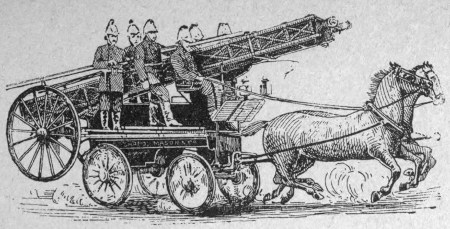
THE NEW HORSED FIRE-ESCAPE,
DESIGNED BY COMMANDER WELLS, CHIEF OFFICER OF THE METROPOLITAN FIRE-BRIGADE.
FIREMEN
AND THEIR EXPLOITS:
WITH SOME ACCOUNT
OF THE RISE AND DEVELOPMENT OF FIRE-BRIGADES,
OF VARIOUS APPLIANCES FOR SAVING LIFE
AT FIRES AND EXTINGUISHING
THE FLAMES.
BY
F. M. HOLMES,
AUTHOR OF "ENGINEERS AND THEIR TRIUMPHS," "MINERS AND
THEIR WORKS UNDERGROUND," ETC.
LONDON:
S. W. PARTRIDGE & CO.,
8 & 9, PATERNOSTER ROW.
1899.

PREFACE.
The present volume, though complete in itself, forms one of a seriesseeking to describe in a popular and non-technical manner the Triumphsof Engineers. The same style has, therefore, been followed which wasadopted in the preceding volumes. The profession of Engineering hasexercised great influence on the work of Fire Extinguishment, as on someother things; and the subject is, therefore, not inappropriate to theseries of books of which the volume forms part.
The story of the Fire-Engine begins in Egypt about a hundred and fiftyyears before Christ. Hero of Alexandria describes a contrivance calledthe "siphon used in conflagrations," and some persons are of opinionthat he was not unacquainted with the use of the air-chest. But it wasnot until nearly two thousand years later—that is, about the close ofthe seventeenth century—that the air-chamber and the hose seem to havebeen brought into anything like general use,—if, indeed, the use can becalled general even then.
Much of the story is involved in obscurity, or it may be there waslittle story to tell; but by the year 1726, Newsham had constructedsatisfactory fire-engines in London; and Braithwaite the engineer—whowith Ericsson constructed the "Novelty" to compete with Stephenson's"Rocket" at the locomotive contest at Rainhill in 1829—built a steamfire-engine about 1830, though it was not until thirty years, or more,later that the use of the machine became general.
As to Fire-Brigades, the Insurance Companies, which began to appearafter the Great Fire of 1666, were wont to employ separate staffs of mento extinguish fires; but by the year 1833, the more important hadunited, and the London Fire-Brigade had been formed under the control ofMr. James Braidwood. Many provincial towns followed the metropolitanmodel in forming their brigades.
Together with the development of the Fire-Engine and of efficientbrigades has been the introduction of various other appliances, such asFire-Escapes, Chemical Extinctors, Water-Towers, and the greatimprovement in the water supply. Nothing is more striking in the historyof conflagrations than the comparison between the dry state of the NewRiver pipes at the Great Fire of 1666 and the copious flood of fivemillion gallons poured into the city in a few hours by the same companyto quench the great Cripplegate fire of November, 1897.
But, indeed, the whole realm of Fire Extinguishment is a world ofconstant
